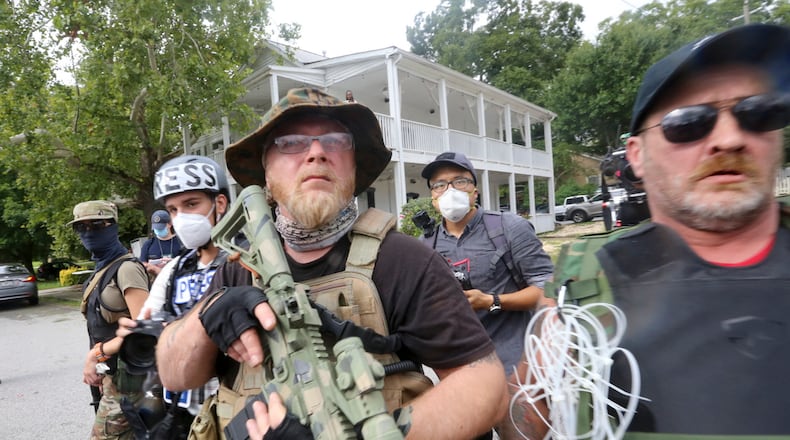Bullets can be dodged only so many times. Now they’ve begun to strike home.
Twice in a matter of days, protests over police violence in two U.S. cities have devolved into armed conflict. In Kenosha, Wisc., a 17-year-old brought his AR-15-style rifle into the city to play vigilante.
Two protesters died, a third was injured, and the young man has been charged with murder. His attorneys say their client, too young to openly carry a weapon under Wisconsin law, acted in self-defense.
On Saturday night, a supporter of President Donald Trump was shot and killed in a clash with Black Lives Matter protesters in the streets of downtown Portland, Ore.
We have shouted, threatened and posed our way into this extremity. I am only surprised — and supremely grateful — that it didn’t happen here first, on Aug. 15, in the village of Stone Mountain.
That Saturday, hundreds of white supremacists were to have conducted a protest within the adjacent state-owned park, with its massive granite carving of two Confederate generals and a politician on horseback.
At past events, many of the white nationalists have been armed with long guns. Counter protesters, too, carried. And so park authorities shut the entire space down – hotels and all.
“If they got in, they’d have 3,200 acres to go crazy,” said Bill Stephens, CEO of the Stone Mountain Memorial Association.
But the white supremacists and their guns came anyway. So did the counter protesters and their guns. Instead of using the park as a venue, they faced off in the village of Stone Mountain.
This was dangerously different. The first visit of armed white supremacists and counter protesters at Stone Mountain Park occurred on April 23, 2016. “The only thing that kept that thing from melting down completely was we put the KKK inside a fenced area and surrounded that area with corrections officers,” Stephens said. “The two groups never got together.”
Ditto for a Fourth of July, surprise demonstration by scores of African Americans, many armed with military-style assault weapons and other firearms, who marched into the park in what an organizer said was a demonstration of their Second Amendment rights.
They were escorted in and out of the park by two dozen law enforcement officers, to ensure against confrontations.
But on Aug. 15, in the village of Stone Mountain, armed militia members, supported by white supremacists, and counter protesters were thrown together — with no police of any sort standing between them.
My Journal-Constitution colleague Chris Joyner, who tracks extremist groups, was on hand.
For several hours, he told me, the two sides faced off in front of the First United Methodist Church as village and county police, augmented by sheriff’s deputies, stayed largely out of sight. The presence of so many openly carried firearms meant that one ill-tempered outburst or breach of trigger discipline could have sent us down the same road as Kenosha or Portland.
Joyner tells of one argument between two armed young men — one on the militia side, the other among the counter demonstrators — that deteriorated into a heated swearing contest.
Finally, the counter demonstrator had enough. “Why don’t you put down that gun and we’ll fight?” he shouted.
“Fight?” Joyner said he sardonically wondered. “Why the heck did you bring the guns?”
The state decision to close the park — and push the volatile confrontation beyond its boundaries — angered local officials and DeKalb CEO Michael Thurmond, who heads a county in which 55% of the population is Black. He admits he didn’t want to see county law enforcement caught between the armed camps.
“Our concern was that DeKalb police officers would be putting themselves in harm’s way to defend a carving,” Thurmond told me. “The decision to close the park suggested that the carving was more important than the safety of not just law enforcement, but also citizens of the village of Stone Mountain and DeKalb.
“You could have closed the park off to civilians. But you couldn’t do that in the village of Stone Mountain,” Thurmond said.
State officials, however, were pleased with the outcome.
‘The decision to deny a free speech permit for the Defending Stone Mountain group and to close the park, was in my opinion, an excellent decision,” Chuck Kelley, police and fire chief for the park, wrote in an after-action report.
“Whenever any Confederate support group is involved in a free speech event,” Kelley wrote, it presents the threat of violence to law enforcement and visitors, requires expensive law enforcement assistance, and results in ’negative press coverage” for the park and private company that manages it.
This is the dilemma of Stone Mountain Park in a nutshell. Back in the 1950s, the state Legislature marked it for a Confederate memorial, a corpse-less cemetery. Half a century and more later, celebrating that fact poses an existential threat to the park.
If only something could be done about the guns. This isn’t a problem confined to Stone Mountain. In the aftermath of the Rayshard Brooks killing by police in June, Atlanta Mayor Keisha Lance Bottoms said armed protesters, operating under Georgia’s open-carry laws, delayed for several days the reclaiming the burned-out Wendy’s that was the site of the shooting.
In the meantime, a “group of armed individuals” at the site stopped and shot up a vehicle, killing an 8-year-old girl inside.
If only there were some sort of law in Georgia.
There is, actually. It says this — emphasis mine:
“No body of men other than the organized militia, components of the armed forces of the United States, and bodies of the police and state constabulary and such other organizations as may be formed under this chapter shall associate themselves together as a military unit or parade or demonstrate in public with firearms.”
Violation of this Georgia law is a misdemeanor. It is still on the books, and has never been repealed, a spokesman for Attorney General Chris Carr confirmed.
Other lawyer friends tell us the statute, which could date back to the mid-1950s, has rarely been litigated — which is a sign that it has also rarely been enforced.
Agree with him or not, John Monroe, legal counsel for the gun-rights group GeorgiaCarry.org, knows his stuff. Monroe said that gun measures passed by the Legislature over the last several years, expanding when and where permitted, concealed weapons can be carried, has probably negated some of this law’s impact.
But he conceded that the law can probably still be applied to the open carrying of long guns.
Monroe is something of a historian and marveled at the change in American gun habits. Concealed weapons were once frowned upon, while the respectable gun owner had no need to keep his firearm under wraps. “Things have changed,” he said.
Today, respectable gun owners carry under the armpit or in a purse. The open carrying of long guns is more provocative. Especially when done in groups, displayed weaponry can’t be considered anything less than an unspoken challenge, even a threat. And in today’s political climate, it is the equivalent of shouting “Fire!” in a crowded theater.
Gun enthusiasts often say that we don’t need new gun laws, that we just need to enforce the ones we have. In this instance, I wholeheartedly agree.
About the Author
The Latest
Featured




